Blaenau Ffestiniog |
|
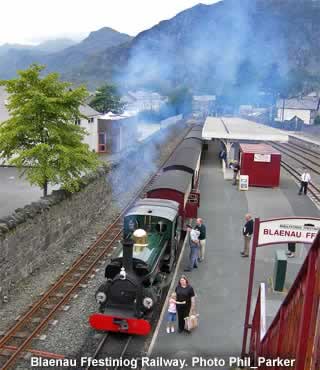 |
|||
The capital of the slate mining industry in the Victorian era |
||
Listen to this article |
||
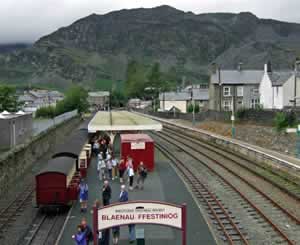 The Blaenau Ffestiniog Railway Station Photo by Katherine Davis |
||
Blaenau Ffestiniog is a small town in Snowdonia. Up until the start of the 18th century, this was a quiet, unremarkable little village. Wales had dozens of others just like it. Soon after that though, the slate mining industry began to take off. The rock had many uses, most notably in roofing buildings. Demand was sky-high, and Blaenau Ffestiniog was lucky enough to have huge deposits of the stuff. The town quickly became the capital of the slate industry. |
||
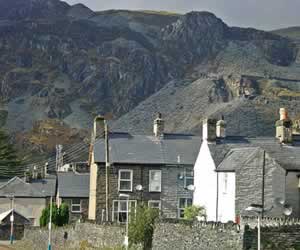 The town of Blaenau Ffestiniog Photo by artq55 |
||
Business has since declined, but during the Victorian era the vast majority of the town's residents worked hard, deep in the belly of the Llechwedd Slate Mines. This underground network of tunnels, caves and caverns has become one of the best tourist attractions in North Wales. |
||
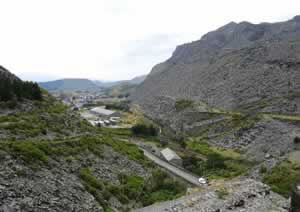 Llechwedd State Mines at Blaenau Ffestiniog Photo by Tamara Kwan |
||
There are two main tours though the mines. The first is the Miners' Tramway, which carries you along a narrow-gauge railway back to 1846. At various points along the way you'll stop off to learn how the mine worked, and what life was like for the real Victorian miners. |
||
The second is the Deep Mine Tour. It delves even further underground, into the depths of the mountain. You make the descent via the steepest passenger railway in the country, which drops down at an angle of 30 degrees. Once you arrive there's a walking tour through the huge caverns, guided by the eerie voice of a Victorian miner. Along most of the way the caves are only lit by tiny bulbs, simulating the candlelight that the workers used to see by. |
||
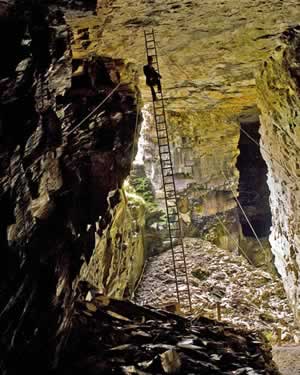 Descending into Llechwedd State Mines Photo by Andrew Stawarz |
||
The tours will make you realise how dangerous the miners' jobs were. They'd work above a 15 metre drop, or from the top of a 26 metre ladder. Children were forced to start work from just 12 years old. You'll also realise that the tours only take you round a very small proportion of the mines. There are at least 40 kilometres of tunnels, snaking off in all directions. |
||
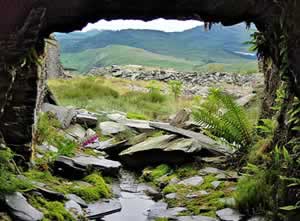 Tunnels leading in all directions at Llechwedd State Mines Photo by Fil-de-fer |
||
After it had been mined, the slate needed to be moved out of town. This was done by building the narrow-gauge Ffestiniog Railway, in the early 19th century. It was the first independent rail company in the entire world. Thanks to an ingenious design, the slate was transported by gravity alone. It rolled down the track all the way to Porthmadog harbour, where it was loaded onto ships. The empty carriages were then dragged back up to Blaenau by horse. After few decades steam trains replaced the horses, and the Ffestiniog Railway became the first narrow-gauge railway in Britain to carry passengers. |
||
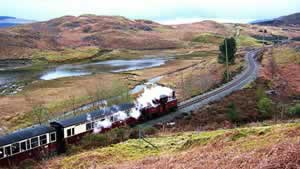 The Ffestiniog Railway to Porthmadog harbour Photo by BRAMBLING |
||
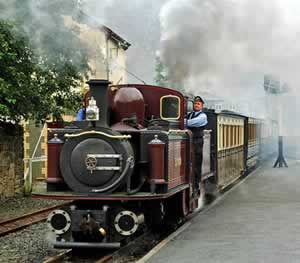 A steam engine on the Ffestiniog Railway Photo by wumpus |
||
As the slate industry declined, so did the railway. Thankfully a group of keen volunteers purchased the line, and turned it into the tourist attraction it is today. The same station is also used by the Conwy Valley Railway. This line heads in the opposite direction, past 12th century castles and the mountains of Snowdonia, to the north coast resort of Llandudno. |
||
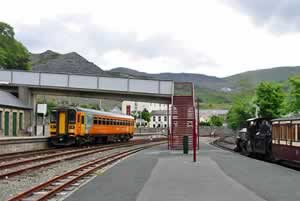 The Conwy Valley Railway, adjacent to the Ffestiniog Railway Photo by Chris McKenna |
||
Throughout the rest of Blaenau Ffestiniog, there are plenty of other reminders of its Victorian past, including a traditional sweet shop, and some preserved toilets that were flushed by river water! Whatever you're doing, it'll almost certainly involve slate in one way or another. You can buy it in shops, or walk on it on the town's staircases. Everywhere in Blaenau is within touching distance of a piece of slate! |
||
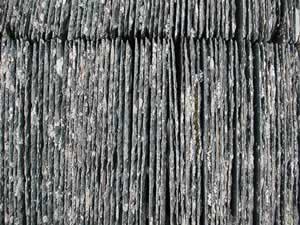 Blaenau Ffestiniog Slate Photo by far closer |
||
The years of mining have turned the town into an unattractive place, with heaps of rubble scattered around like discarded rubbish. Blaenau wasn't included within the Snowdonia National Park, despite sitting within its borders. On the other hand, it would be a shame to write the place off as a dump. Slate has always been an important resource, and its presence has left the town with plenty of fun and interesting attractions. Thanks to the miners' efforts, Blaenau Ffestiniog became known as "the town that roofed the world". |
||
|
||
Ffestiniog Railway run trains daily, April to October, 10am to around 6pm (plus limited trains in winter). Rover tickets cost around £19 for adults, £17 children. Stations - Porthmadog, Minffordd, Penrhyn, Tan-y-Bwlch, Blaenau Ffestiniog. Tel: 01766 516000 |
||
|
Pocket Britain is optimised for use on a smartphone or tablet with internet access. All content is subject to copyright. All reasonable methods have been used to ensure information supplied is accurate at the time of publication. However, it is advisable to check information before relying on it. Privacy Policy |